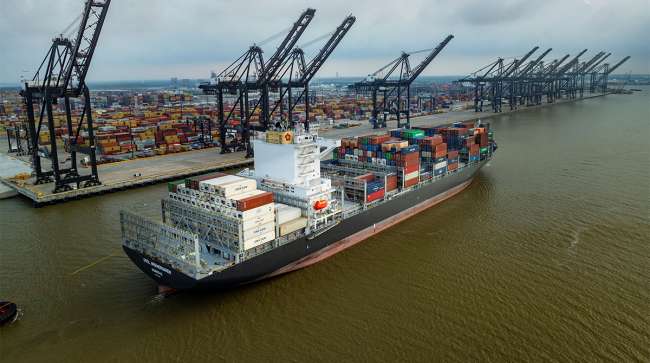Staff Reporter
Largest US Ports Report Volume Declines For May

[Stay on top of transportation news: Get TTNews in your inbox.]
U.S. ports posted a mixed bag of results for May, with certain facilities seeing volume gains while some of the nation’s largest saw container traffic decline.
The Port of Los Angeles said it processed 752,893 20-foot equivalent units for the month, a 3% decline from the 779,140 moved in May 2023. This ended nine consecutive months of year-over-year growth for the facility, but container volumes for the first five months are still up 18% year-over-year.
“We continue our trend of strong, consistent volume that started at the beginning of the year,” Port of Los Angeles Executive Director Gene Seroka said during a media briefing. “As we gear up for the second half of the year, our forecast indicates more robust activity on our docks throughout the summer.”
The neighboring Port of Long Beach reported that May container volumes decreased 8.2% year-over-year to 695,937 containers from 758,225, driven by shifting trade routes and canceled voyages during the month. This ended eight consecutive months of year-over-year growth at the port. Despite the May drop, container volumes at Long Beach through the first five months of the year were up 10% compared with year-ago levels of 3,449,181.
“I am confident we will see additional cargo as we work with industry partners to rebuild our market share in this increasingly competitive environment,” said Port of Long Beach CEO Mario Cordero. “Looking ahead, I anticipate a moderate increase in cargo as we move into summer and we recapture business.”
The @PortofOakland's container volume continues its upward trend. Total cargo volume increased 5.3% in May 2024 compared to May 2023, with 188,040 TEUs (twenty-foot containers). Full import cargo volume in the first five months of this year increased significantly compared to the… pic.twitter.com/EniMgtgJRx — Port of Oakland (@PortofOakland) June 17, 2024
The Port of Oakland reported that container volume increased 5.3% year-over-year to 188,040 from 178,513, the seventh straight month of rising annual import volumes. Overall, continued gains in import cargo volume were offset by slight declines in export volumes.
Also, port leadership recently traveled to Taiwan to meet with ocean carrier executives to discuss infrastructure investments, reducing emissions and new inland rail connections.
The Northwest Seaport Alliance noted that combined volumes between the ports of Seattle and Tacoma, Wash., increased 20.6% to 277,388 from 229,974 TEUs. The alliance noted that voyage consistency, increased vessel calls and low import rail dwells continue to drive strong container volumes in the gateway. Container volumes for the first five months of the year were up 8.2% at 1,235,446.
Port Houston reported a 21% year-over-year volume increase to 364,866 containers from 307,879 a year ago. It attributed the gains to robust construction, strong manufacturing in the state and regional consumer spending on items like furniture, hardware and retail goods. Container volumes for the first five months of the year increased 14% to 1,758,960. Port officials also welcomed the MV/OOCL Bremerhaven on its maiden voyage in May.
“We give a Texas-sized welcome to the MV/OOCL Bremerhaven and look forward to providing this new vessel with exceptional customer service,” said Roger Guenther, executive director at Port Houston. “At Port Houston’s container terminals, vessels are worked 24 hours a day, and are turned quickly in partnership with our stevedores and ILA labor. We understand the importance of getting ships in, out and on their way to their next destination as quickly and efficiently as possible.”
Port Houston welcomed the M/V OOCL Bremerhaven on its maiden voyage to our Bayport Container Terminal.
The OOCL Bremerhaven container vessel is part of the weekly CMA-CGM Victory Bridge Service, with a fleet of 7 vessels and 10 ports of call. #PortHouston #Terminal #Welcome pic.twitter.com/WP5iH2jErN — Port Houston (@Port_Houston) June 3, 2024
Georgia Ports Authority said container volumes increased 22% year-over-year to 490,330 from 408,686. Port leadership noted that a strengthening retail market combined with business from new customers is driving substantial growth. The facility is also benefiting from source shifting, as more manufacturers establish production facilities in Southeast Asian locations, it said.
“Major retail customers tell Georgia Ports they have increased their orders to rebuild inventories and to meet rising consumer demand,” said GPA President Griff Lynch. “Additionally, we’ve seen an increase in trade among Tier 1 suppliers for the new Hyundai Meta Plant, which also added to our May container volumes.”
Busy day yesterday as the Port of Baltimore welcomes back more and more ships!
90 degree temperatures don’t stop our great @ILAUnion from loading and unloading vessels at our Dundalk and Seagirt terminals. @portsamericahq Chesapeake #BaltimoreIsBack #ThePortForOurNation pic.twitter.com/zCc4wcMh2j — Port of Baltimore (@portofbalt) June 21, 2024
The Port of Baltimore and Port of Virginia did not have data available at press time. Both ports have experienced disruptions in their normal operations in the aftermath of the Francis Scott Key Bridge collapse in Baltimore on March 26. Maryland Gov. Wes Moore announced the full reopening of the port June 12.
“We finish the work we start,” Moore said. “We can look out onto the Patapsco and see that the Dali is gone and the wreckage has been cleared. But I will not be satisfied until I can look out on the Patapsco River from this spot and see the Key Bridge standing tall again. That is the push. That is the promise. And by moving in partnership, we will make it reality.”
The South Carolina Ports Authority did not have its May numbers available.
The Port Authority of New York and New Jersey usually runs one month behind the other ports in releasing its numbers. In April, the port authority experienced a 9.4% increase year-over-year in volume to 709,469 containers from 648,462.
Want more news? Listen to today's daily briefing below or go here for more info:




